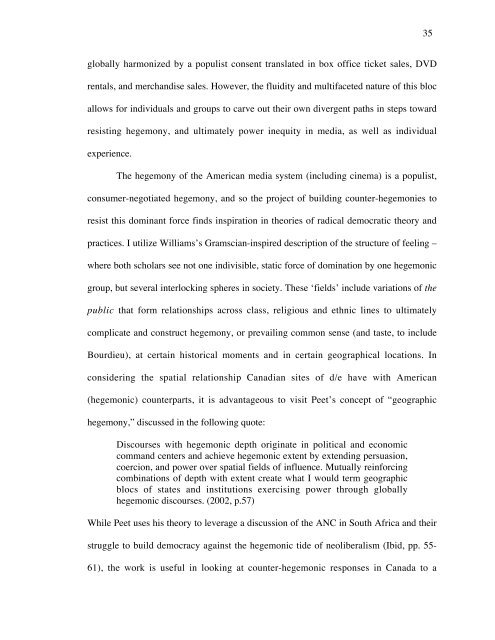The Spaces Between Grassroots Documentary ... - Ezra Winton
The Spaces Between Grassroots Documentary ... - Ezra Winton
The Spaces Between Grassroots Documentary ... - Ezra Winton
You also want an ePaper? Increase the reach of your titles
YUMPU automatically turns print PDFs into web optimized ePapers that Google loves.
globally harmonized by a populist consent translated in box office ticket sales, DVD<br />
rentals, and merchandise sales. However, the fluidity and multifaceted nature of this bloc<br />
allows for individuals and groups to carve out their own divergent paths in steps toward<br />
resisting hegemony, and ultimately power inequity in media, as well as individual<br />
experience.<br />
<strong>The</strong> hegemony of the American media system (including cinema) is a populist,<br />
consumer-negotiated hegemony, and so the project of building counter-hegemonies to<br />
resist this dominant force finds inspiration in theories of radical democratic theory and<br />
practices. I utilize Williams’s Gramscian-inspired description of the structure of feeling –<br />
where both scholars see not one indivisible, static force of domination by one hegemonic<br />
group, but several interlocking spheres in society. <strong>The</strong>se ‘fields’ include variations of the<br />
public that form relationships across class, religious and ethnic lines to ultimately<br />
complicate and construct hegemony, or prevailing common sense (and taste, to include<br />
Bourdieu), at certain historical moments and in certain geographical locations. In<br />
considering the spatial relationship Canadian sites of d/e have with American<br />
(hegemonic) counterparts, it is advantageous to visit Peet’s concept of “geographic<br />
hegemony,” discussed in the following quote:<br />
Discourses with hegemonic depth originate in political and economic<br />
command centers and achieve hegemonic extent by extending persuasion,<br />
coercion, and power over spatial fields of influence. Mutually reinforcing<br />
combinations of depth with extent create what I would term geographic<br />
blocs of states and institutions exercising power through globally<br />
hegemonic discourses. (2002, p.57)<br />
While Peet uses his theory to leverage a discussion of the ANC in South Africa and their<br />
struggle to build democracy against the hegemonic tide of neoliberalism (Ibid, pp. 55-<br />
61), the work is useful in looking at counter-hegemonic responses in Canada to a<br />
35


